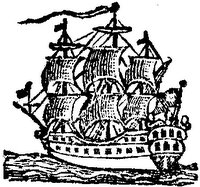When Did Susanna Rowson First Come to America?
Many of the details in that book chapter do match contemporaneous accounts of Rowson’s passage across the Atlantic Ocean as a young girl. As dramatic as the hardships described in Rebecca are, they closely echo what the Boston press reported in early 1768.
The first reports appeared on 1 Feb 1768, saying that the brig Abigail under Capt. James Harding Stevens had reached Boston harbor the preceding Thursday, 28 January. “Capt. Stevens left England the 9th November,” said the Boston Chronicle; “he met with contrary winds the whole passage.” The Boston Evening-Post added: “He has been from London 14 weeks, but last from the Downs [off the English coast] in 10 Weeks; they had very bad Weather on the Coast, and most the People on board, (35 in Number) are more or less Frost-bitten.”
The 4 February Boston News-Letter agreed: “most of the People belonging to the Vessel had their Hands and Feet froze.” Also, “the Ship’s Company were at a short Allowance for 5 Weeks before their Arrival, being 36 Persons in Number Passengers included.” That confirms Rowson’s memory of the food shortage, though the newspapers didn’t print anecdotes about her own family.
And then the Abigail ran aground. It was “in a snow storm, drove ashore on Lovel’s-island, and can’t be got off without unloading part of her cargo,” said the Chronicle. The Evening-Post was optimistic, saying, “’tis thought [it] will be got off without much Damage.”
By 4 February, the News-Letter could say, “they are taking out the Goods.” And on 8 February the Evening-Post updated its readers: “The Brig Abigail, Capt. Stevens, from London, mentioned in our last to be drove ashore at Lovell’s island, is since got off and is come up to Town.”
Newspapers and Boston town records confirm that Lt. William Haswell, late of the Royal Navy (and known to Bostonians since he’d helped to patrol their harbor in the early 1760s), and his family were aboard the Abigail. They don’t describe how he lowered his little daughter over the ship’s rail on a rope so a sailor could carry her to shore, but it seems certain that Susanna Rowson didn’t invent that experience.
When Rowson set the landing of the ship in Rebecca in January 1767, she might have been quietly fictionalizing her experience. Or she might have been genuinely confused about what year she arrived in Boston—after all, she was only five years old at the time. But because her ship’s passage was so awful, we have the documentation to say for certain that Rowson first touched land in America on the morning of 29 Jan 1768.
(In the image above, Lovell’s Island isn’t labeled but lies to the right of the words “Ship Channel.”)


